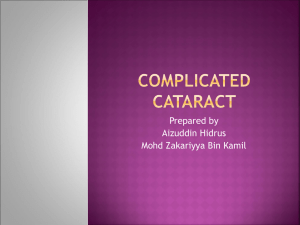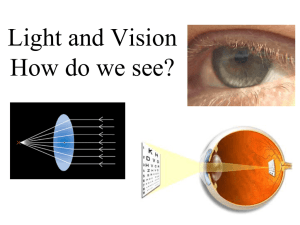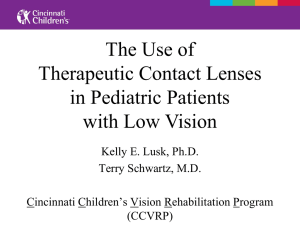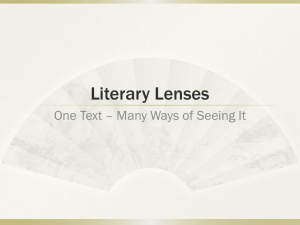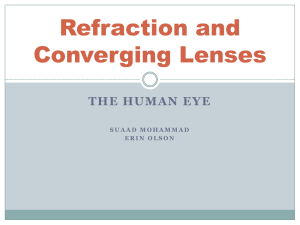Pediatric aphakia treatment
advertisement
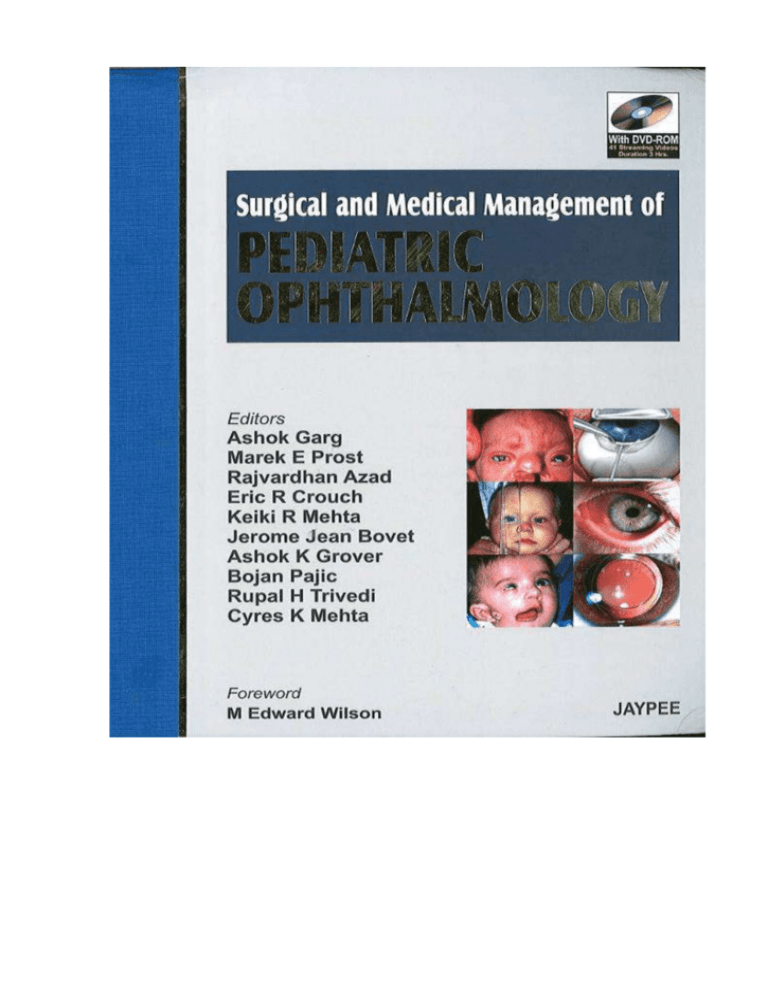
2 3 Good visual acuity and binocular vision in children with unilateral and bilateral cataracts may be attained nowadays, in much greater percentage of children following the removal of the congenital cataracts.(16,39,48,56,63) The best outcomes after surgery depend on several variables. This includes the extend of cataract, associated ocular or systemic abnormalities, early diagnosis and removal of cataract, optimum optical correction, and aggressive visual rehabilitation for several years.(40,). Understanding of amblyopia development and reversal, especially in the early sensitive period of life, is much improved. Surgical techniques of cataract removal and possibility of the optical correction of aphakic eyes have also been refined. Critical period of visual development are the first few months of life. Visual areas in the brain are developing rapidly in response to the visual stimuli from the eyes( 9,13,53).. One should however remember that not every cataract is amblyogenic since birth. If the cataract is not complete and central, even nuclear cataract and increases gradually with the child’s age, prognosis for the improvement of vision is much better. This is why progressive cataract, such as lamellar cataracts, PHPV, posterior lenticonus, and bilateral cataracts without nystagmus, have quite a good prognosis, also when the surgery is performed a little later, after the critical period of visual development.(60) In case of the complete cataract, it is better to operate in the first weeks of child’s life, up to 2 months of age. It is true for both monocular and binocular cataracts. Appropriate conditions for the development of a good visual acuity and binocular vision are thus created. Now, many clinicians choose the primary monocular lens implantation (IOL) technique, which was routinely performed in the older children, over 2 years of age at least. However, it is still controversial surgery in newborns as it is associated with several complications(7,24,57,58). Other solution is post-operative aphakia correction with contact lenses(2,15,28.,35,36,43). It seems that the use of the contact lenses with secondary IOL later in life is more beneficial. However, the crucial role in achievement of the good result of treatment is played by the proper visual rehabilitation. It includes appropriate optical correction and intensive obturation of the sound eye in case of monocular cataract. Concomitant strabismus and nystagmus should also be treated with the use of appropriate methods. Optical correction Aphakic glasses Actually, aphakic glasses are very rarely used in the correction of post-operative monocular or binocular aphakia in children. Contraindication to the use of aphakic glasses is their bad optics. First of all, these glasses are narrowing visual field to about 30º, increasing nystagmus in the child. They produce marked retinal size disparity in the form of enlargement of the viewed objects by about 30% (41,53). Abnormal eye stimulation lead to the formation of abnormal visual retinal perception . It is associated with the development of amblyopia and nystagmus, and frequently the concomitant strabismus. Prismatic effect produced by highly refractile glasses, frequently over +16.0 Dsph, and sometimes even up to +28.0 Dsph, shifts the visual perceptions received by the retinal receptors, leading to the strabismus. Difference in refractive error over 3.0 Dsph or 1.5 Dcyl unable proper choices of glasses. Due to anisometropia and associated with it necessity to receive by CNS two different images produce confusion which may lead to permanent suppression(amblyopia) or anomalous retinal correspondence with development of the concomitant strabismus. My own long experience shows that the use of aphakic glasses in young children brings about poor therapeutical result. Visual acuity in children with binocular aphakia, wearing glasses for 7 to 9 years, is within 0.05 to 0.3, horizontal, vertical, and often rotational nystagmus is always present, whereas convergent, divergent or vertical strabismus is seen in about 80% of patients(38). One can not talk about the development of binocular vision in such a case (3,21,53,59) 4 Next disadvantage of wearing glasses by newborns and infants is their relatively high weight and large size. It is debilitating visually, cosmetically, and psychologically. The use of glasses in the correction of aphakia is justified in exceptional and rare cases of the contact lenses intolerance or the lack of co-operation with child’s parents. It seems, however, that the secondary IOL, independent of child age, is much better solution in such cases. Epikeratophakia It was used in the past. Epikeratophakia may correct residual aphakia and is reversible corneal procedure (31,32,). However, this procedure is associated with several complications. Moreover, epikeratophakic graft is no longer commercially available. Indications to epikeratophakia may only be cases of the contact lenses intolerance with unilateral aphakia, in whom IOL implantation can not be performed (serious intraocular inflammation). Contact lenses The best optical device in the post-operative aphakia is contact lenses. In children following unilateral cataract removal these lenses are the primary treatment associated with the obturation of the normal eye. Contact lenses should be selected immediately after the congenital cataract surgery. Refraction should be measured with the use of computer as well as keratometric measurement of the corneal toricity. Manual autokeratorefractometer, Retinomax K-plus (Nikon) is used for this purpose. There is no need to use general anesthesia (see Chapter: Concomitant Strabismus; fig. 20). Each type of lenses should be worn during waking hours and removed at night (62) Types of contact lenses There are 3 types of the contact lenses for pediatric use: 1. Rigid gas permeable (RGP) lenses. 2. Silicon elastomer lenses. 3. Hygrogel lenses. Rigid gas permeable (RGP) lenses are the best choice in the treatment of aphakia in children. Nowadays, the majority of clinicians apply this type of contact lenses (5,20,30,37,43,). Special fitting considerations. are required in case of microphthalmic eyes following the operation of congenital cataract, with very steep cornea, and medium post-operative astigmatism. Also small diameter of the cornea, narrow lid slit with closely adjacent and highly tense lids require the use of RGP lenses.. Lenses, properly selected and fitted exactly to the size of cornea, are ordered for each treated child individually. After refraction and keratometry measurement, in case of RGP, lenses are selected from the trial lens set, and fluoresceine pattern should be evaluated. Optical power of the lens to be ordered is calculated from the special table of the contact lens power and may range from 12.0 Dsph to 30.0 Dsph. Radius of the lens is a mean value of 2 measurements but steeper by 0.1 mm than the flattest corneal reading, and ultimately dependent on the corneal toricity and fluoresceine patterns.(see Fig. 1) An overall lens diameter must be adjusted to the diameter of the cornea, smallest possible to enable an appropriate movement of about 1 mm around the center. In the youngest children, lens diameter is markedly lower than that in adults and is within the range of 8.7 to 9.5 mm. Wright has found that a good fitting relationship cannot be found with silicone elastomer material (62). 5 Fig. 1 Fluorescein pattern of RGP lens in infant. Properly fitted lens provides a normal exchange of tears between the cornea and lens. It enables removal of metabolic wastes and dead conjunctival and corneal epithelial cells as well as maintenance of excellent oxygenation of the cornea. It guarantees normal metabolism and breathing of the cornea, comparable to those in the eyes without contact lenses. RGP is the healthiest lens for the small developing eye, in comparison with other types of the contact lenses. It is also easily applicable and simple in the everyday care that is very important for parents (see Fig. 2). 6 Fig. 2 RGP lens application in the aphakic child. Silicone elastomer lenses are highly permeable for oxygen, even higher than RGP lenses. In the seventies and eighties of the last century, such contact lenses were commonly used (1,18,26) Actually, RGP contact lenses are used in the aphakia correction following the congenital cataract surgical treatment. Optic power of the silicone elastomer lenses is available according to the individual orders. Radius of the posterior lens curvature is only 7.4 to 8.2 mm that does not always permit proper fitting, especially in small children with steep cornea. Diameter of lens is only 11.0 mm. Such a lens is too large for small eyeball in newborns and infants. Therefore, some problems with application and removal of lens by parents are noted. Due to the properties of silicon elastomer material in which lipid-mucin deposits cumulate easily and may lead to the corneal and conjunctival complications, such a lens should be worn during waking hours only. Advantages and disadvantages of the contact lenses are shown in Table I. TABLE I. ADVANTAGES AND DISADVANTAGES OF VARIOUS CONTACT LENS MATERIALS Advantages Disadvantages RGP High oxygen permeability Small diameter Some initial discomfort Difficult fitting procedure Individual fitting Position inside tear film Movements with blinking Constant tears exchange beetwen cornea and lens Appropriate corneal nourishment Removal of the metabolic wastes No penetration of lipid-mucin deposits No bacterial growth Lack of neovascularization Lack of giant papillary Neutralizing of astigmatism (to 3 D) Easy to handle Daily wear Expensive Very rarely possible adherence to the corneal surface Silicone elastomer Superior corneal oxygenation Extended wear possibility Low loss rate Wearing comfort Neutralizing of only small astigmatism Limited power of lenses Limited base curve Not good fitting relationship Difficult fitting procedure Expensive 7 Lipid-mucin deposits accumulation Corneal complications Giant papillary Poor moistening of lens surface Possible adherence to the corneal Surface Hydrogel lenses, in principle, should be used in children over 4 years of life. These are commercially manufactured lenses of selected parameters only. Optic power ranges from –40.0 to +40.0. Radius of the posterior curvature is 8.0 to 9.5 mm, and the diameter 13.5 to 14.5 mm. There is no possibility to order lenses individually and it is a disadvantage in case of the small eyeballs and steep cornea in newborns and infants. One of the most important physico-chemical properties is oxygen permeability, which is defined as Dk/L where: Dk amount of oxygen passing through unit area of lens material per unit of time and at specified difference in temperature and pressure; L thickness of the central optic zone. This property is examined in vitro and given in the tables as lens permeability. Corneal oxygenation and its proper metabolism depend on oxygen permeability of the lens and oxygen access to the cornea in vivo. (37) It is so-called equivalent oxygen percentage (EOP) and is the most universal clinical assessment of the lens quality. Corneal EOP in the atmospheric air is 21%. Accepted EOP for the contact lenses of the prolonged wear is 17.9%, and daily wear 9.9% (see Diagram 1). DIAGRAM 1. CONTACT LENS THICKNESS AND EQUIVALENT OXYGEN PERCENTAGE (37) EOP % 21 air 18 maximal extended- wear CL 15 minimal 12 optimal for daily-wear CL 9 6 3 total hypoxia 0 0 0,1 0,2 0,3 CONTACT LENS THICKNESS HYDROGEL CL RGP SILICONE ELASTOMER 8 In pediatric aphakia lens power needed to its correction are very high and is associated with big central thickness of the lens. It makes very low oxygen permeability. It may lead to several corneal, and conjunctival ( giant papillary, conjunctivitis, neovascularization, infective keratitis, corneal edema, endothelial polymegathism, abrasions, acute red eye reaction).It is very unhealthy lens for the small and developing eyeball. Its only advantage is a low price. This lens is used in only exceptional cases. Intraocular lens (IOL) More and more clinicians implant IOL every year. It results, first of all, from the improvement of surgical techniques and preferences of parents for IOL implants versus correction with contact lens, facilitating later visual rehabilitation. Intraocular lens implantation is also associated with lower further costs (55). Use of IOL in newborns and infants is still controversial. Changes in refraction in the growing child are marked and significantly differ in the individual children. The most rapid growth and development of the eyeball takes place up to 2 years of age, reaching the values similar to those in adults in about 6 – 7 years.. In this time, length of the eyeball increases from 17.0 m to 21.0 – 22.0 mm (in adults: 23.0 to 24.0 mm), and corneal refractive power from 53 Dsph to 45 Dsph (in adults: 43 Dsph to 42 Dsph). Respectively to these changes, power of IOL needed for implantation is also changing. Prost(45) carried out the detailed statistical studies in the group of 1300 Polish children, evaluating changes in the above mentioned 3 parameters in children followed up from the birth to 14 years of age (see Chapter Operative Techniques in Pediatric Cataract Surgery; Fig. 7 – 12) It would advocate the secondary IOL implantation. On the other hand, Lamber et al. (25) reported the results of studies comparing IOL implantation to the primary aphakia with contact lens correction. The authors report that the number of the secondary surgical operations is larger in the group with IOL (visual axis opacification VAO; glaucoma; secondary IOL) than in the group of patients wearing contact lenses. But mean visual acuity has been slightly better in the IOL group. Other clinicians think that mean visual acuity is similar in both groups of the treated children (15, 18,54,55). Monocular and binocular aphakia treatment Congenital monocular or binocular cataracts removal in the first weeks of child’s life, optical correction and good visual rehabilitation create proper conditions for the development of good visual acuity and binocular vision. In monocular aphakia, an occlusive patch must always be worn over the sound eye for 90% of the waking day.(42,44,61) Frequent follow-up visits are necessary to reduce the occlusion as soon as possible, when vision and fixation of aphakic eye become correct. It is evaluated with tests used in optokinetic nystagmus (OKN) or using variants of preferential looking (PL). Monocular fixation is being evaluated with eye fundus examination with visuscope (see Chapter Concomitant Strabismus; figs. 13, 14, 19). When satisfactory visual acuity has been attained, strabismus and nystagmus are being treated. Residual amblyopia is treated simultaneously with penalization methods or atropine application to the sound eye. In such a way binocular peripheral vision is being stimulated. Concomitant strabismus more frequently accompanies unilateral aphakia whereas the nystagmus most often accompanies bilateral aphakia.(4,12) Esotropia is seen in over 70% of cases of both unilateral and bilateral aphakia, while exotropia in about 20% of cases. Hypertropia is also very frequent, especially in the unilateral aphakia. Oblique overaction encounters for about 25% of cases.(37 ) 9 Concomitant strabismus is treated both nonsurgically and surgically. Brief scheme of treatment is shown in Table II. TABLE II. SCHEME FOR TREATMENT OF CHILD AFTER UNILATERAL OR BILATERAL CONGENITAL CATARACT REMOVAL VISUAL REHABILITATION UNILATERAL APHAKIA BILATERAL APHAKIA OCCLUSION OF NORMAL EYE DAILY RGP WEARING PENALIZATION PLEOPTIC TREATMENT PRISMATIC CORRECTION ORTHOPTIC TREATMENT BTA INJECTIONS STRABISMUS/ NYSTAGMUS SURGERY To correct the angle of strabismus, prismatic glasses are used together with exercises in hypercorrection glasses. Botulinum toxin may also be injected to decrease the angle of strabismus or nystagmus. In case of deviations more than 30 PD or noncompliance with nonsurgical treatment, surgical treatment of strabismus is necessary. Orthoptic rehabilitation is carried out for many years, even to 8 – 10 years of life. Detailed strabismus management is described in the Chapter Concomitant Strabismu Management,. Satisfactory visual acuity (0.6 – 1.0) and some degree of binocularity may be achieved in many patients congenital unilateral and bilateral cataract, was reported by many authors (9,10,25,42,44,53). Also my previous published studies have documented that such a good resukts can be achieved if the surgery is performed in the first weeks of age, operated eye being fitted with contact lens, and adequate visual rehabilitation being carried out for the whole period of visual development. Over 10-year observation of these children therapy enables the conclusion, that good visual 10 acuity of 0.7 – 1.0 at distance, and 1.0 at near with low fusion range is attainable in unilateral congenital cataract. Sensory fusion and stereoacuity was achieved only by children after binocular congenital cataract removal. Such excellent results of treatment are not possible in all children due to various causes. They were achieved by about 30% of the treated children.(38). Gregg and Parks (17) reported a case of patient with unilateral infantile cataract who had bifoveal fusion with good stereoacuity. These studies show that binocular vision with stereopsis may also be obtained in patients with unilateral congenital cataract. However, achievement of so satisfactory results require excellent co-operation of ophthalmologist with the treated child and parents. It is required as much art as science. Especially important is the thrust to the doctor and great patience and devotion of parents because the treatment is long-lasting and complicated. However, the prize is worth such an effort. References 1. Aasuri MK, Venkata Preetam P, Rao NT. Management of pediatric aphakia with silsoft contact lenses. CLAO J 1999;25:209-212. 2. Amos C. R, Lambert S.R., Ward M.A.: RGP contact lens correction of aphakia following congenital cataract removal during infancy. J Pediatr. Ophthalmol. & Strabismus 1992; 29 (4):243-245. 3. Assaf AA, Wiggins R, Engel K, Senft S. Compliance with prescribed optical correction in cases of monocular aphakia in children. Saudi J Ophthalmol 1994;8:15-22. 4. Autrata R., Likaj M., Senkova K.,Vodićkova K.,Rehurek I: Binocular visus results after primary IOL implantation versus contact lenses correction in the treatment of infantile monocular aphakia. Folia Strab Neuroophthalmol. 2005; VIII; 32-39 Suppl. L 5. Baker JD. Visual rehabilitation of aphakic children. II. Contact lenses. Surv Ophthalmol 1990;34:366-371 6. Becker RH, Hubisch SH, Graf MH, Kaufmann H. Preliminary report: examination of young children with LEA symbols. Strabismus 2000;8:209-213. 7. Ben Ezra D., Paez J.H.: Congenital cataract and intraocular lenses. Am J Ophthalmol 1983:96:311-314 8. Birch E.E., Stager D.R.: Prevalens of good visual acuity following surgery for congenital unilateral cataract. Arch Ophthalmol, 1988:106:40-43. 9. .Birch E.E., Stager D.R.: The critical period for surgical treatment of dense congenital unilateral cataract. Invest Ophthalmol Visual Sci: 1996; 37(8): 1532-8 10. Cho MH, Morgan Wild MW, BW. eds. Spectacles Principles Philadelphia: Lippincott, 1990:192-206. and for children. Practice of In: Rosenbloom Pediatric AA, Optometry. 11 11. Cutler S.J., Nelson L.B., Calhoun J.H.; Extended wear contact lenses in pediatric aphakia. J Pediatr Ophthalmol Surg , 1985;22:86-91. 12. Brown S.M., Archer S., Del Monte M.A.: Stereopsis and binocular vision after surgery for unilateral infantile cataract. J of AAPOS, 1999; 3(2):109-113. 13. Daw NW. Critical periods and amblyopia. Arch Ophthalmol 1998;116:502-505. 14. Dutton JJ. Visual rehabilitation of aphakic children. Surv Ophthalmol, 1990;34:365. 15. Epstein RJ. Contact lenses for the correction of pediatric aphakia. In: International Ophthalmology Clinics. Boston, MA: Little, Brown, 1991:53-60. 16. Gelbart SS, Hoyt CS, Jastrebski G, and Marg E: Long-term visual results in bilateral congenital cataracts. Am J Ophthalmol 1982;93:615, 17. Gregg FM, Parks MM: Stereopsis after congenital monocular cataract extarction. Am J Ophthalmol 1992, 114;314-317. 18. Halberg GP. Contact lenses for infants and children. In: Harley RD, ed. Pediatric Ophthalmology. 2nd ed. Philadelphia: W. B. Saunders,1975:1280-1288. 19. Hiles DA. Visual rehabilitation of aphakic children. III. Intraocular lenses. Surv Ophthalmol 1990;34:371-379. 20. Jacobs DS. The best contact lens for baby. In: JakobiecFA, ed. International Ophthalmology Clinics. Boston, MA, Little, Brown, 1991:173-179. 21. Katsumi O, Miyanaga Y, Hirose T, et al: Binocular function in unilateral aphakia. Correlation with aniseikonia and stereoacuity. Ophthalmology 1988,95:1088-1093. 22. Kulgelberg U.; Visual acuity following treatment of bilateral congenital cataracts. Doc Ophthalmol, 1992;82(3):211-215. 23. Lambert S.R., Drack A.V.:Infantile cataracts.Surv Ophthalmol 1996; 40(6): 427-58. 24. Lambert SR, Lynn M, Drews-Botsch C, et al. Intraocular lens implantation during infancy: perceptions of parents and the American Association for Pediatric Ophthalmology and Strabismus members./AAPOS 2003;7:400-405. 25. Lambert S.R., Lynn M., Plager D.A. at al.: A comparison of grating visual acuity, strabismus and reoperation outcomes among children with aphakia and pseudoaphakia after unilateral cataract surgery during the first six months of live. JAAPOS2001: 5; 7075. 26. Levin AV, Edmonds SA, Nelson LB, et al: Extended-wear contact lenses for the treatment of pediatric aphakia. Ophthalmology 95:1107, 1988. 27. Lewis T.L., Mauer D., Brent H.P.: Development of grating acuity in children treated for unilateral or bilateral congenital cataract. Invest. Ophthalmol Vis Sci 1996; 36(10): 208087. 12 28. Ma JJ, Morad Y, Mau E, et al. Contact lenses for the treatment of pediatric cataracts. Ophthalmology 2003;110:299. 29. McClatchey S.K., Dahan E., et all: A comparison of the ratę of refractive growth in pediatric aphakic and pseudophakic eyes. Ophthalmology 2000 ;107:118-122. 30. McQuaid K, Young TL. Rigid gas permeable contact lens changes in the aphakic infant. CLAO J 1998;24:36-40. 31. Morgan KS, McDonald MB, Hiles DA, et al. The nationwide study of epikeratophakia for aphakia in children. Am J Ophthalmol 1987;103:366-374. 32. Morgan K.S., Asbell P.A., May J.G., McDonald M.B. et all: Surgical and visual results of pediatrie epikeratophakia. Methods Pediatr Syst Ophthalmol; 1983:745-751. 33. Leat SJ, Wegmann D. Clinical testing of contrast sensitivity in chil dren: age-related norms and validity. Optom Vis Sci 2004;81:245-254. 34. Lewis TL, Maurer D, Brent HP. Development of grating acuity in children treated for unilateral and bilateral congenital cataract. Invest Ophthalmol Vis Sci 1995;36:20802095. 35. Morris J. Pediatric contact lens practice. In: Barnard S, Edgar D,eds. Pediatric Eye Care. Cambridge, MA: Blackwell Science, 1995:312-323.s 36. Nelson N.B., Cutler S.J., Calhoun J.H., Wilson T.W., Harley R.D.: Silsoft extended wear contact lenses in pediatric aphakia. Ophthalmology 1985; 92:1529-31. 37. Oleszczyńska-Prost E.: Conact lenses in: Prost M. (ed.): Problems in pediatric ophthalmology. PZWL, Warsaw ,Poland 1998, pp. 323-336. 38. Oleszczyńska-Prost E: Evaluation of visual function after congenital cataract surgery in children wearing rigid gas permeable contact lenses. Contactology and Ophthalmol Optics, Poland, 2000:2:11-17. 39. Parks MM: Management of cataracts in infants. Pediatric ophthalmology and strabismus; Transactions of the New Orleans Academy of Ophthalmology. New York, Raven Press, 1986. 40. Parks MM: Visual results in aphakic children. Am J Oph thalmol 94:441, 1982. 41. Piippo LJ, Coats DK. Pediatric spectacle prescription. Comp Ophthalmol Update 2002;3:113-122. 42. Pratt-Johnson J.A., Tillson G.: Visual result after removal of congenital cataracts before the age of l year Can J Ophthalmol, 1981;l6:19-21. 43. Pratt-Johnson J.A., Tillson G.: Hard contact lenses in the management of uni-lateral cataracts. J Pediatr Ophthalmol, 1985; 22:94-96. 44. Pratt-Johnson J.A., Tillson G.: Unilateral congenital cataract: binocular status after treatment Ped Ophthalmol &Strabismus, 1989; 26:72-75. 13 45. Prost M. (ed.): Development of the human eye in children. Children’s Memorial Health Institute Publications, 2000, Warsaw, Poland. 46. Rogers G.L.; Extended wear contact lenses in children with cataract .Ophthalmology 1980;87:867-870. 47. Riddell PM, Ladenheim B, Mast J, et al. Comparison of measures of visual acuity in infants: Teller acuity cards and sweep visual evoked potentials. Optom Vis Sci 1997;74:702-707. 48. Robb EM, Mayer DL, and Moore BD: Results of early treatment of unilateral cataracts. J Pediatr Ophthalmol Strabismus 24:178, 1987. 49. Rogers GL, Tishler CL, Tsou BH, et al: Visual acuities in infants with congenital cataracts operated on prior to 6 months of age. Arch Ophthalmol 99:999, 1981. 50. Simmers AJ, Gray LS, McGraw PV, Winn B. Contour interaction for high and low contrast optotypes in normal and amblyopic observers. Ophthal Physiol Opt 1999;19:253-260. 51. Stenson SM. Pediatric contact lenses. Ophthalmol Clin North Am 1996;9:129-136.Visual evoked responses at 3 months post-term age in human infants. Invest Ophthalmol Vis Sci 1997;38(Suppl):S62. 52. Suttle CM. Visual acuity assessment in infants and young children. Clin Exp Optom 2001:84:337-345. 53. Terri L.L., Maurer D., Brent H.P. :Development of grating acuity in children treated for unilateral or bilateral congenital cataract. Inwest Ophthalmol and \ Visual Sci: 1995: 36(10); 2080-95. 54. Trivedi visual RH, axis Wilson after ME, cataract Bartholomew surgery LR, and et single al. Opacification acrylic of intraocular the lens implantation in the first year-of-life. I AAPOS 2004;8:156-164. 55. Trivedi RH, Wilson ME : Aphakia in:. Pediatric cataract surgery, Lippincott Williams &Wilkins, Philadelphia,2005: 270-277. 56. Wilson ME. Management of aphakia in childhood. Focal Points Am Acad Ophthalmol 1999:1-18. 57. Wilson ME, Bluestein EC, Wang XH. Current trends in the use of intraocular lenses in children. J Cataract Refract Surg 1994;20:579-583. 58. Wilson ME. Intraocular lens implantation: Has it become the standard of care for children? Ophthalmology 1996;103:1719-1720. 59. Wright KW, Matusmoto E, and Edelman PM: Binocular vision and stereopsis associated with early surgery for on ocular Ophthalmol 1992,10:1607. congenital cataracts. Arch 14 60. Wright KW, Christensen LE, and Noguchi BA: Results of late surgery for presumed congenital cataracts. Am J phthalmol 1992,114: 409-415. 61. Wright KW, Wehrle MJ, and Urrea PT: Bilateral total occlusion during the critical period of visual development. Arch Ophthalmol 1987,105:321. 62. Wright KW: Lens abnormalities, in: Pediatric ophthalmology and strabismus,Mosby,St.Louis,1995:367-389. 63. Yamamoto M., Dogru M., et all: Visual function following congenital cataract surgery. Japan J Ophthalmol, 1998: 42(5): 411-16.


